Experimental Safety Analysis for Transplanting Device of the 4-Bar Link Type Semi-Automatic Vegetable Transplanter
Abstract
:1. Introduction
2. Materials and Methods
2.1. Vegetable Transplanter Used in This Study
2.2. Load Measurement System
2.3. Work Conditions
2.4. Analysis of Measured Data
2.4.1. Static Safety Factor
2.4.2. Dynamic Safety (Fatigue Life)
3. Results and Discussion
3.1. The Stress Data
3.2. Static Safety
3.3. Dynamic Safety (Fatigue Life)
4. Conclusions
- The static safety factor was more than 1.0 for all locations and working conditions. The minimum static safety factor was 1.88 at the location of S_12 under the operating condition of an engine speed of 1250 rpm and a planting distance of 0.29 m.
- The minimum fatigue life was 49,153.3 h at the location of S_14 under the operating condition of an engine speed of 750 rpm and a planting distance of 0.35 m. Considering 25.5 h of annual usage time of vegetable transplanter, the minimum fatigue life of the transplanting device was 1928 years.
- The stress on the transplanting device tends to decrease when the engine speed and planning distance increases. Therefore, the static safety factor and the fatigue life are increased with the engine speed and planting distance.
- It can be concluded that the transplanting device understudy was designed to be safe statically and dynamically in the working environments. The link was directly connected to the crank of the transplanting transmission received the largest load and has the highest stress, so that part requires robust design.
Author Contributions
Funding
Informed Consent Statement
Conflicts of Interest
Appendix A
| Engine Speed (rpm) | Planting Distance (m) | Static Safety Factor | ||||||||||||||||
|---|---|---|---|---|---|---|---|---|---|---|---|---|---|---|---|---|---|---|
| S_1 | S_2 | S_3 (σv) | S_3 (τmax) | S_4 (σv) | S_4 (τmax) | S_5 | S_6 | S_7 | S_8 | S_9 | S_10 | S_11 | S_12 | S_13 | S_14 | S_15 | ||
| 750 | 0.29 | 45.46 | 39.23 | 16.00 | 16.18 | 12.60 | 11.07 | 4.17 | 4.41 | 4.96 | 13.13 | 8.34 | 10.20 | 14.58 | 6.50 | 12.22 | 4.11 | 5.37 |
| 0.31 | 55.67 | 47.99 | 19.53 | 19.91 | 15.32 | 14.95 | 5.43 | 5.71 | 6.44 | 16.75 | 9.42 | 9.72 | 23.77 | 8.38 | 17.32 | 5.79 | 5.31 | |
| 0.33 | 74.29 | 55.78 | 19.68 | 19.60 | 16.32 | 15.40 | 6.00 | 6.23 | 6.96 | 17.51 | 6.99 | 9.62 | 18.87 | 8.56 | 17.86 | 5.67 | 5.41 | |
| 0.35 | 34.21 | 30.38 | 11.01 | 11.41 | 9.20 | 10.64 | 2.95 | 3.15 | 3.57 | 9.79 | 5.96 | 7.58 | 9.10 | 4.36 | 9.68 | 2.58 | 4.93 | |
| 0.37 | 50.26 | 33.70 | 12.75 | 13.16 | 9.26 | 10.40 | 3.50 | 3.74 | 4.35 | 12.93 | 6.64 | 8.73 | 11.91 | 5.58 | 11.85 | 3.53 | 4.94 | |
| 0.39 | 64.55 | 51.09 | 14.51 | 15.02 | 11.00 | 13.72 | 3.58 | 3.85 | 4.49 | 14.20 | 8.35 | 10.06 | 13.66 | 6.52 | 13.16 | 3.69 | 4.93 | |
| 0.41 | 70.34 | 55.58 | 13.66 | 14.14 | 12.06 | 11.13 | 4.34 | 4.49 | 4.94 | 12.99 | 7.93 | 8.51 | 18.77 | 6.88 | 14.17 | 4.29 | 4.97 | |
| 0.43 | 40.35 | 24.23 | 10.21 | 10.91 | 6.42 | 7.10 | 2.88 | 3.22 | 3.64 | 8.58 | 5.32 | 6.39 | 9.61 | 4.91 | 10.40 | 3.27 | 4.92 | |
| 0.45 | 47.85 | 42.66 | 11.21 | 11.80 | 8.86 | 10.62 | 3.78 | 3.98 | 4.45 | 10.26 | 6.62 | 7.62 | 17.82 | 6.53 | 13.07 | 4.15 | 5.14 | |
| 0.47 | 73.07 | 52.40 | 12.08 | 12.53 | 9.57 | 10.63 | 3.84 | 4.03 | 4.48 | 12.39 | 7.83 | 8.16 | 17.77 | 6.28 | 14.43 | 4.52 | 4.90 | |
| 1000 | 0.29 | 62.05 | 49.06 | 11.35 | 12.02 | 8.35 | 8.44 | 3.43 | 3.68 | 4.33 | 11.17 | 5.58 | 6.14 | 12.61 | 7.14 | 11.16 | 4.47 | 5.46 |
| 0.31 | 55.48 | 43.06 | 19.66 | 19.67 | 13.99 | 14.60 | 4.55 | 4.88 | 5.60 | 17.81 | 8.08 | 9.36 | 19.08 | 8.22 | 13.50 | 5.48 | 5.32 | |
| 0.33 | 65.74 | 60.01 | 20.01 | 20.21 | 9.75 | 8.98 | 5.31 | 5.72 | 6.85 | 18.44 | 8.45 | 9.16 | 23.07 | 10.22 | 16.06 | 7.76 | 5.25 | |
| 0.35 | 72.83 | 61.42 | 15.52 | 15.99 | 8.12 | 7.39 | 5.03 | 5.33 | 6.09 | 15.66 | 8.61 | 8.49 | 19.12 | 8.81 | 18.67 | 6.55 | 5.23 | |
| 0.37 | 56.12 | 68.93 | 11.95 | 12.43 | 6.12 | 5.61 | 4.53 | 4.85 | 5.53 | 12.41 | 7.60 | 6.89 | 16.71 | 7.62 | 15.75 | 4.92 | 5.17 | |
| 0.39 | 55.28 | 61.91 | 11.59 | 11.98 | 7.16 | 6.56 | 4.48 | 4.72 | 5.30 | 13.11 | 8.29 | 7.19 | 18.45 | 7.75 | 15.77 | 4.59 | 5.14 | |
| 0.41 | 62.83 | 60.70 | 13.65 | 14.01 | 8.28 | 7.37 | 4.41 | 4.67 | 5.26 | 10.83 | 7.54 | 8.17 | 16.97 | 6.79 | 13.98 | 4.29 | 4.95 | |
| 0.43 | 63.53 | 56.05 | 10.13 | 10.62 | 6.93 | 6.45 | 3.54 | 3.82 | 4.49 | 9.20 | 6.80 | 6.48 | 15.78 | 6.37 | 12.44 | 3.91 | 4.85 | |
| 0.45 | 55.60 | 46.29 | 18.25 | 18.82 | 17.23 | 27.88 | 6.73 | 6.95 | 7.67 | 18.54 | 13.70 | 10.29 | 28.01 | 6.28 | 21.95 | 6.54 | 5.11 | |
| 0.47 | 45.41 | 39.05 | 17.09 | 18.70 | 19.20 | 21.42 | 7.01 | 7.08 | 7.57 | 19.21 | 13.80 | 10.24 | 28.11 | 2.07 | 20.67 | 6.32 | 5.50 | |
| 1250 | 0.29 | 34.39 | 33.23 | 15.97 | 16.87 | 16.65 | 20.83 | 5.53 | 5.89 | 6.76 | 18.64 | 8.66 | 7.87 | 18.95 | 1.88 | 16.84 | 7.38 | 5.35 |
| 0.31 | 58.13 | 57.35 | 15.33 | 15.85 | 13.06 | 13.41 | 5.81 | 6.15 | 6.92 | 18.72 | 10.94 | 8.67 | 12.55 | 6.73 | 17.40 | 5.67 | 5.31 | |
| 0.33 | 46.91 | 54.78 | 17.99 | 18.47 | 16.83 | 16.21 | 6.28 | 6.54 | 7.28 | 19.09 | 10.98 | 8.91 | 12.64 | 6.22 | 17.75 | 5.69 | 5.22 | |
| 0.35 | 62.32 | 60.46 | 10.38 | 11.07 | 9.58 | 8.56 | 4.43 | 4.67 | 5.15 | 15.82 | 8.41 | 6.40 | 15.19 | 5.53 | 12.32 | 4.47 | 5.05 | |
| 0.37 | 58.69 | 80.42 | 15.51 | 16.30 | 15.22 | 13.66 | 5.99 | 6.26 | 6.90 | 17.79 | 11.85 | 8.80 | 19.32 | 6.25 | 16.80 | 6.28 | 5.12 | |
| 0.39 | 50.70 | 82.18 | 11.55 | 12.36 | 10.92 | 9.72 | 5.50 | 5.67 | 6.18 | 16.49 | 9.82 | 6.93 | 17.23 | 5.41 | 16.42 | 4.33 | 4.96 | |
| 0.41 | 67.85 | 88.82 | 14.82 | 15.64 | 14.30 | 12.79 | 5.67 | 5.83 | 6.33 | 16.78 | 10.27 | 8.20 | 22.91 | 5.56 | 17.58 | 5.02 | 5.02 | |
| 0.43 | 75.32 | 77.35 | 25.43 | 26.29 | 25.48 | 24.39 | 7.96 | 8.49 | 9.91 | 18.24 | 13.64 | 13.45 | 19.67 | 5.73 | 32.11 | 8.73 | 4.96 | |
| 0.45 | 89.57 | 70.81 | 16.44 | 17.25 | 15.55 | 14.19 | 6.48 | 6.68 | 7.35 | 17.41 | 12.06 | 9.49 | 22.61 | 5.88 | 20.43 | 5.24 | 5.04 | |
| 0.47 | 92.23 | 79.36 | 11.79 | 12.49 | 11.32 | 10.09 | 5.31 | 5.36 | 5.67 | 16.81 | 10.37 | 7.32 | 20.77 | 5.40 | 16.07 | 4.02 | 4.87 | |
| 1500 | 0.29 | 42.67 | 63.51 | 16.55 | 17.32 | 14.79 | 13.64 | 7.33 | 7.58 | 8.40 | 19.68 | 10.23 | 8.09 | 8.67 | 6.01 | 20.32 | 5.23 | 5.19 |
| 0.31 | 67.96 | 64.63 | 12.64 | 13.21 | 11.91 | 11.16 | 5.46 | 5.68 | 6.37 | 16.92 | 8.93 | 7.08 | 9.38 | 5.28 | 15.24 | 4.74 | 5.33 | |
| 0.33 | 68.14 | 66.41 | 31.49 | 32.93 | 28.77 | 29.55 | 14.46 | 14.61 | 15.83 | 27.11 | 15.74 | 11.08 | 16.32 | 6.29 | 39.57 | 8.00 | 5.07 | |
| 0.35 | 68.91 | 82.72 | 18.62 | 19.71 | 16.21 | 14.76 | 7.78 | 8.26 | 9.50 | 20.46 | 11.75 | 8.97 | 11.88 | 6.03 | 22.58 | 6.36 | 5.19 | |
| 0.37 | 90.80 | 75.13 | 20.76 | 21.66 | 19.71 | 18.24 | 7.79 | 8.30 | 9.60 | 20.62 | 13.67 | 10.80 | 10.42 | 5.73 | 27.02 | 5.48 | 5.19 | |
| 0.39 | 82.92 | 74.57 | 16.81 | 17.43 | 14.04 | 13.85 | 5.40 | 5.77 | 6.54 | 15.74 | 10.48 | 8.87 | 13.68 | 5.53 | 15.96 | 5.14 | 5.03 | |
| 0.41 | 75.16 | 69.72 | 10.46 | 11.00 | 9.89 | 8.80 | 4.63 | 4.76 | 5.17 | 12.94 | 8.37 | 6.42 | 13.94 | 4.89 | 12.72 | 4.05 | 4.95 | |
| 0.43 | 89.74 | 86.89 | 16.61 | 17.11 | 17.65 | 15.93 | 6.34 | 6.70 | 7.26 | 16.13 | 10.75 | 8.79 | 13.49 | 5.27 | 18.23 | 5.32 | 4.94 | |
| 0.45 | 94.20 | 85.58 | 21.66 | 22.28 | 20.95 | 19.58 | 7.61 | 8.13 | 9.12 | 19.21 | 10.45 | 11.38 | 22.18 | 6.00 | 26.31 | 6.68 | 5.02 | |
| 0.47 | 96.74 | 68.33 | 15.87 | 16.30 | 13.84 | 12.81 | 5.93 | 6.01 | 6.43 | 15.87 | 9.62 | 10.06 | 18.40 | 5.44 | 16.74 | 4.03 | 4.95 | |
| Engine Speed (rpm) | Planting Distance (m) | Fatigue Life (Hours) | ||||||||||||||
|---|---|---|---|---|---|---|---|---|---|---|---|---|---|---|---|---|
| S_1 | S_2 | S_3 | S_4 | S_5 | S_6 | S_7 | S_8 | S_9 | S_10 | S_11 | S_12 | S_13 | S_14 | S_15 | ||
| 750 | 0.29 | 1.54 × 1012 | 1.70 × 1012 | 5.85 × 109 | 9.96 × 108 | 9.36 × 105 | 1.43 × 106 | 3.18 × 106 | 9.32 × 107 | 3.99 × 106 | 1.09 × 107 | 6.72 × 108 | 1.41 × 107 | 2.95 × 108 | 6.89 × 105 | 1.58 × 106 |
| 0.31 | 5.61 × 1013 | 2.53 × 1013 | 3.86 × 1010 | 7.25 × 108 | 1.04 × 107 | 1.63 × 107 | 3.37 × 107 | 8.45 × 108 | 3.21 × 107 | 4.07 × 107 | 3.00 × 109 | 5.52 × 107 | 5.98 × 109 | 1.29 × 107 | 1.47 × 106 | |
| 0.33 | 1.67 × 1014 | 1.31 × 1013 | 2.6 × 1010 | 7.36 × 108 | 7.99 × 106 | 1.14 × 107 | 2.17 × 107 | 4.77 × 108 | 1.32 × 107 | 3.39 × 107 | 2.08 × 109 | 4.18 × 107 | 3.82 × 109 | 4.01 × 106 | 1.68 × 106 | |
| 0.35 | 1.39 × 1011 | 8.58 × 1010 | 4.99 × 108 | 2.62 × 108 | 1.50 × 105 | 2.38 × 105 | 5.70 × 105 | 1.18 × 107 | 7.69 × 105 | 2.53 × 106 | 2.11 × 107 | 1.71 × 106 | 5.96 × 107 | 4.92 × 104 | 1.14 × 106 | |
| 0.37 | 2.23 × 1012 | 4.11 × 1011 | 3.32 × 109 | 4.49 × 108 | 8.03 × 105 | 1.31 × 106 | 3.31 × 106 | 7.06 × 107 | 4.06 × 106 | 1.08 × 107 | 2.40 × 108 | 9.75 × 106 | 4.67 × 108 | 4.90 × 105 | 1.37 × 106 | |
| 0.39 | 2.66 × 1013 | 2.89 × 1012 | 8.90 × 109 | 1.08 × 108 | 1.57 × 106 | 2.30 × 106 | 4.93 × 106 | 1.03 × 108 | 6.65 × 106 | 1.36 × 107 | 1.01 × 109 | 2.14 × 107 | 1.10 × 109 | 1.03 × 106 | 1.37 × 106 | |
| 0.41 | 9.96 × 1013 | 3.32 × 1012 | 7.48 × 109 | 4.28 × 108 | 1.40 × 106 | 2.02 × 106 | 4.25 × 106 | 1.02 × 108 | 8.56 × 106 | 1.61 × 107 | 9.42 × 108 | 2.09 × 107 | 9.23 × 108 | 1.13 × 106 | 1.39 × 106 | |
| 0.43 | 2.53 × 1012 | 3.35 × 1010 | 6.79 × 108 | 1.30 × 108 | 1.16 × 105 | 1.92 × 105 | 4.65 × 105 | 7.31 × 106 | 5.88 × 105 | 2.13 × 106 | 2.97 × 107 | 2.70 × 106 | 4.32 × 107 | 1.71 × 105 | 1.11 × 106 | |
| 0.45 | 2.63 × 1014 | 1.69 × 1012 | 3.16 × 109 | 3.87 × 108 | 9.29 × 105 | 1.30 × 106 | 2.59 × 106 | 5.07 × 107 | 5.66 × 106 | 1.28 × 107 | 1.49 × 109 | 1.17 × 107 | 5.69 × 108 | 1.61 × 105 | 1.43 × 106 | |
| 0.47 | 2.62 × 1013 | 5.66 × 1012 | 2.22 × 109 | 4.87 × 108 | 7.47 × 105 | 1.01 × 106 | 1.93 × 106 | 4.21 × 107 | 4.60 × 106 | 1.23 × 107 | 8.29 × 108 | 8.90 × 106 | 4.17 × 108 | 1.13 × 106 | 1.39 × 106 | |
| 1000 | 0.29 | 5.23 × 1012 | 2.45 × 1012 | 1.19 × 109 | 2.54 × 108 | 2.10 × 105 | 3.46 × 105 | 9.53 × 105 | 3.37 × 107 | 7.97 × 105 | 2.82 × 106 | 9.35 × 107 | 5.81 × 106 | 1.22 × 108 | 2.06 × 105 | 1.42 × 106 |
| 0.31 | 1.03 × 1013 | 2.01 × 1012 | 1.59 × 1010 | 3.16 × 108 | 1.52 × 106 | 2.41 × 106 | 6.01 × 106 | 2.56 × 108 | 7.50 × 106 | 1.64 × 107 | 1.28 × 109 | 3.66 × 107 | 7.27 × 108 | 1.87 × 106 | 1.35 × 106 | |
| 0.33 | 1.85 × 1014 | 6.70 × 1013 | 5.84 × 1010 | 1.71 × 108 | 1.75 × 107 | 3.07 × 107 | 7.22 × 107 | 1.01 × 109 | 4.04 × 107 | 5.56 × 107 | 2.65 × 109 | 1.06 × 108 | 1.50 × 1010 | 2.87 × 107 | 1.30 × 106 | |
| 0.35 | 1.26 × 1014 | 3.60 × 1013 | 8.71 × 1010 | 1.87 × 108 | 1.06 × 107 | 1.88 × 107 | 4.50 × 107 | 9.08 × 108 | 4.02 × 107 | 4.09 × 107 | 2.33 × 109 | 7.61 × 107 | 1.28 × 1010 | 1.30 × 107 | 1.25 × 106 | |
| 0.37 | 2.30 × 1013 | 9.89 × 1012 | 1.21 × 1010 | 1.06 × 108 | 1.37 × 106 | 2.20 × 106 | 5.23 × 106 | 1.69 × 108 | 5.38 × 106 | 1.33 × 107 | 9.77 × 108 | 2.54 × 107 | 9.81 × 108 | 1.18 × 106 | 1.20 × 106 | |
| 0.39 | 1.25 × 1013 | 2.66 × 1013 | 3.86 × 1010 | 2.44 × 108 | 1.91 × 106 | 2.93 × 106 | 6.69 × 106 | 1.33 × 108 | 8.17 × 106 | 1.70 × 107 | 1.16 × 109 | 2.88 × 107 | 1.41 × 109 | 1.18 × 106 | 1.09 × 106 | |
| 0.41 | 1.46 × 1013 | 4.19 × 1012 | 1.42 × 1010 | 1.06 × 108 | 1.34 × 106 | 1.85 × 106 | 3.71 × 106 | 1.18 × 108 | 5.49 × 106 | 9.73 × 106 | 8.22 × 108 | 1.42 × 107 | 7.74 × 108 | 6.22 × 105 | 9.89 × 105 | |
| 0.43 | 3.26 × 1013 | 3.29 × 1012 | 3.14 × 109 | 9.35 × 108 | 5.24 × 105 | 7.64 × 105 | 1.67 × 106 | 3.02 × 107 | 2.52 × 106 | 6.03 × 106 | 5.14 × 108 | 9.60 × 106 | 2.87 × 108 | 3.58 × 105 | 9.35 × 105 | |
| 0.45 | 5.23 × 1015 | 1.28 × 1015 | 2.1 × 1012 | 1.53 × 1012 | 5.06 × 108 | 6.79 × 108 | 9.02 × 108 | 9.68 × 106 | 1.45 × 109 | 2.26 × 108 | 1.29 × 1010 | 3.95 × 107 | 1.23 × 1011 | 2.18 × 108 | 1.13 × 106 | |
| 0.47 | 1.60 × 1016 | 1.34 × 1015 | 7.11 × 1011 | 1.1 × 1013 | 1.66 × 109 | 2.03 × 109 | 1.70 × 109 | 4.82 × 109 | 2.84 × 109 | 4.05 × 108 | 1.03 × 1010 | 2.72 × 107 | 1.21E+10 | 9.32E+07 | 1.15 × 106 | |
| 1250 | 0.29 | 1.20 × 1014 | 3.43 × 1014 | 2.87 × 1011 | 7.16 × 1010 | 6.70 × 108 | 1.11 × 109 | 1.31 × 109 | 1.40 × 1010 | 1.17 × 108 | 2.41 × 107 | 2.45 × 108 | 4.10 × 107 | 3.07 × 1010 | 6.82 × 106 | 8.49 × 105 |
| 0.31 | 2.79 × 1013 | 7.37 × 1013 | 8.71 × 109 | 5.84 × 109 | 6.20 × 106 | 9.45 × 106 | 1.75 × 107 | 1.01 × 109 | 2.18 × 107 | 1.40 × 107 | 2.82 × 108 | 6.32 × 106 | 2.14 × 109 | 1.68 × 106 | 8.71 × 105 | |
| 0.33 | 2.32 × 1013 | 2.12 × 1012 | 1.59 × 1010 | 2.91 × 1010 | 1.19 × 107 | 1.78 × 107 | 3.24 × 107 | 2.27 × 109 | 3.16 × 107 | 1.93 × 107 | 4.52 × 108 | 4.19 × 106 | 3.88 × 109 | 3.30 × 106 | 8.28 × 105 | |
| 0.35 | 3.53 × 1012 | 5.87 × 1012 | 3.91 × 109 | 4.73 × 109 | 7.79 × 105 | 1.14 × 106 | 2.27 × 106 | 2.38 × 108 | 5.49 × 106 | 7.02 × 106 | 2.49 × 108 | 1.35 × 106 | 2.46 × 108 | 3.05 × 105 | 7.83 × 105 | |
| 0.37 | 2.13 × 1014 | 1.01 × 1014 | 5.46 × 1010 | 1.25 × 1011 | 1.02 × 107 | 1.58 × 107 | 3.06 × 107 | 1.30 × 109 | 3.88 × 107 | 3.20 × 107 | 1.21 × 109 | 4.71 × 106 | 3.86 × 109 | 2.32 × 106 | 1.02 × 106 | |
| 0.39 | 5.61 × 1013 | 3.53 × 1013 | 2.37 × 1010 | 3.97 × 1010 | 4.05 × 106 | 6.12 × 106 | 1.22 × 107 | 5.43 × 108 | 1.72 × 107 | 1.78 × 107 | 8.16 × 108 | 2.74 × 106 | 2.58 × 109 | 8.46 × 105 | 9.12 × 105 | |
| 0.41 | 5.17 × 1014 | 3.15 × 1013 | 1.83 × 1010 | 2.98 × 1010 | 4.51 × 106 | 6.36 × 106 | 1.12 × 107 | 4.57 × 108 | 1.79 × 107 | 2.14 × 107 | 1.03 × 109 | 2.22 × 106 | 2.10 × 109 | 6.48 × 105 | 9.36 × 105 | |
| 0.43 | 3.70 × 1015 | 5.56 × 1014 | 2.03 × 1011 | 8.1 × 1011 | 7.64 × 107 | 1.20 × 108 | 2.53 × 108 | 2.50 × 109 | 4.08 × 108 | 2.26 × 108 | 4.45 × 109 | 6.19 × 106 | 1.03 × 1011 | 1.88 × 107 | 9.65 × 105 | |
| 0.45 | 3.68 × 1015 | 9.41 × 1012 | 5.06 × 1010 | 1.77 × 1011 | 1.80 × 107 | 2.46 × 107 | 4.58 × 107 | 1.44 × 109 | 9.26 × 107 | 8.75 × 107 | 2.24 × 109 | 3.67 × 106 | 1.02 × 1010 | 2.54 × 106 | 9.29 × 105 | |
| 0.47 | 5.55 × 1014 | 1.87 × 1013 | 8.27 × 109 | 1.88 × 1010 | 3.43 × 106 | 4.34 × 106 | 6.91 × 106 | 4.50 × 108 | 1.90 × 107 | 2.03 × 107 | 6.66 × 108 | 1.81 × 106 | 1.78 × 109 | 3.67 × 105 | 7.78 × 105 | |
| 1500 | 0.29 | 7.38 × 1012 | 1.55 × 1013 | 1.9 × 1010 | 2.31 × 1010 | 2.89 × 107 | 4.01 × 107 | 7.12 × 107 | 1.50 × 109 | 1.64 × 107 | 7.97 × 106 | 8.65 × 106 | 1.01 × 106 | 4.14 × 109 | 2.10 × 105 | 6.01 × 105 |
| 0.31 | 2.40 × 1013 | 1.07 × 1013 | 5.99 × 109 | 5.74 × 109 | 2.45 × 106 | 3.45 × 106 | 6.74 × 106 | 3.83 × 108 | 7.43 × 106 | 6.05 × 106 | 1.93 × 107 | 5.39 × 106 | 7.13 × 108 | 2.01 × 105 | 6.42 × 105 | |
| 0.33 | 1.02 × 1016 | 2.25 × 1015 | 2.21 × 1012 | 6.58 × 1012 | 4.26 × 109 | 1.04 × 1010 | 1.01 × 1010 | 1.39 × 1010 | 3.01 × 108 | 3.86 × 107 | 1.68 × 108 | 3.27 × 106 | 3.12 × 1011 | 2.82 × 106 | 6.66 × 105 | |
| 0.35 | 3.99 × 1012 | 3.97 × 1013 | 7.59 × 1010 | 4.73 × 1010 | 1.25 × 108 | 2.05 × 108 | 3.36 × 108 | 3.41 × 109 | 1.05 × 108 | 2.22 × 107 | 2.04 × 108 | 2.26 × 106 | 3.22 × 1010 | 1.74 × 106 | 7.17 × 105 | |
| 0.37 | 1.19 × 1014 | 1.28 × 1014 | 1.07 × 1011 | 1.73 × 1011 | 3.89 × 107 | 6.50 × 107 | 1.34 × 108 | 3.34 × 109 | 8.75 × 107 | 3.56 × 107 | 6.02 × 108 | 2.88 × 106 | 2.62 × 1010 | 3.78 × 106 | 8.32 × 105 | |
| 0.39 | 1.17 × 1013 | 1.54 × 1013 | 1.86 × 1010 | 5.87 × 1010 | 4.10 × 106 | 6.49 × 106 | 1.50 × 107 | 5.34 × 108 | 1.78 × 107 | 1.52 × 107 | 4.36 × 108 | 1.43 × 106 | 2.14 × 109 | 5.79 × 105 | 7.33 × 105 | |
| 0.41 | 3.69 × 1012 | 4.46 × 1012 | 3.37 × 109 | 8.99 × 109 | 1.07 × 106 | 1.48 × 106 | 2.76 × 106 | 1.25 × 108 | 4.51 × 106 | 6.58 × 106 | 1.84 × 108 | 1.01 × 106 | 2.62 × 108 | 1.96 × 105 | 6.85 × 105 | |
| 0.43 | 6.29 × 1013 | 1.20 × 1014 | 4.05 × 1010 | 1.5 × 1011 | 1.54 × 107 | 2.40 × 107 | 4.90 × 107 | 1.23 × 107 | 5.79 × 107 | 4.66 × 107 | 8.97 × 108 | 1.88 × 106 | 6.46 × 109 | 1.73 × 106 | 8.13 × 105 | |
| 0.45 | 1.93 × 1015 | 4.98 × 1013 | 7.71 × 1010 | 4.11 × 1011 | 5.58 × 107 | 8.98 × 107 | 1.86 × 108 | 2.54 × 109 | 6.18 × 107 | 1.09 × 108 | 1.75 × 109 | 4.13 × 106 | 2.33 × 1010 | 5.88 × 106 | 8.97 × 105 | |
| 0.47 | 4.91 × 1014 | 7.56 × 1012 | 7.84 × 109 | 5.04 × 1010 | 6.97 × 106 | 9.24 × 106 | 1.50 × 107 | 6.65 × 108 | 7.62 × 106 | 2.18 × 107 | 4.94 × 108 | 1.77 × 106 | 1.64 × 109 | 3.75 × 105 | 8.14 × 105 | |
References
- Kim, S.K.; Park, S.; Kwak, J.H.; Choi, S.K.; Chae, W.B.; Yang, E.Y.; Lee, M.J.; Jang, Y.; Seo, M.H.; Lee, S.H.; et al. Proper plant density for mechanical transplanting of several leafy vegetables under Korean agricultural condition. J. Biosyst. Eng. 2019, 44, 276–280. [Google Scholar] [CrossRef]
- Hwang, S.J.; Park, J.H.; Lee, J.Y.; Shim, S.B.; Nam, J.S. Optimization of main link lengths of transplanting device of semi-automatic vegetable transplanter. Agronomy 2020, 10, 1938. [Google Scholar] [CrossRef]
- Iqbal, M.Z.; Islam, M.N.; Ali, M.; Kiraga, S.; Kim, Y.J.; Chung, S.O. Theoretical overturning analysis of a 2.6-kW two-row walking-type automatic pepper transplanter. J. Biosyst. Eng. 2022, 47, 79–91. [Google Scholar] [CrossRef]
- Moon, S.D.; Min, Y.B.; Park, J.C. Analysis of working capacity of a hand-fed transplanter. J. Bio. Fac. Environ. 1997, 6, 159–167. Available online: https://www.koreascience.or.kr/article/JAKO199711922405384.pdf (accessed on 5 February 2022).
- Shao, Y.; Liu, Y.; Xuan, G.; Hu, Z.; Han, X.; Wang, Y.; Chen, B.; Wang, W. Design and Test of Multifunctional Vegetable Transplanting Machine. IFAC-Pap. Line 2019, 52, 92–97. [Google Scholar] [CrossRef]
- Khadatkar, A.; Mathur, S.M.; Gaikwad, B.B. Automation in transplanting: A smart way of vegetable cultivation. Curr. Sci. 2018, 115, 1884–1892. [Google Scholar] [CrossRef]
- Kumar, G.V.P.; Raheman, H. Vegetable transplanters for use in developing countries—A review. Int. J. Veg. Sci. 2008, 14, 232–255. [Google Scholar] [CrossRef]
- Park, J.H.; Hwang, S.J.; Nam, J.S. Operational characteristics of a domestic commercial semi-automatic vegetable transplanter. J. Agric. Life Sci. 2018, 52, 127–138. [Google Scholar] [CrossRef]
- Jo, J.S.; Okyere, F.G.; Jo, J.M.; Kim, H.T. A Study on Improving the Performance of the Planting Device of a Vegetable Transplanter. J. Biosyst. Eng. 2018, 43, 202–210. [Google Scholar] [CrossRef]
- Paraforos, D.S.; Griepentrog, H.W.; Vougioukas, S.G. Methodology for designing accelerated structural durability tests on agricultural machinery. Biosyst. Eng. 2016, 149, 24–37. [Google Scholar] [CrossRef]
- Han, J.; Moon, S.; Lee, G.; Kang, D. Experimental method for durability evaluation of a chisel mounted on a composite working implement. J. Biosyst. Eng. 2017, 42, 251–257. [Google Scholar] [CrossRef]
- Balda, M.; Svoboda, J. An influence of static load on fatigue life of parts under combined stress. J. Appl. Comput. Mech. 2008, 2, 5–12. Available online: https://www.kme.zcu.cz/acm/old_acm/full_papers/acm_vol2no1_p001.pdf (accessed on 7 March 2022).
- Paraforos, D.S.; Griepentrog, H.W.; Vougioukas, S.G.; Kortenbruck, D. Fatigue life assessment of a four-rotor swather based on rainflow cycle counting. Biosyst. Eng. 2014, 127, 1–10. [Google Scholar] [CrossRef]
- Han, J.; Kim, E.; Moon, S.; Lee, H.; Kim, J.; Park, Y. Fatigue integrity assessment for tractor-mounted garlic-onion harvester. J. Terramech. 2022, 100, 1–10. [Google Scholar] [CrossRef]
- Andrusca, L.; Goanta, V.; Barsanescu, P.; Savin, A.; Comanici, A.M. Stress State Evaluation in Biaxially Loaded Cruciform Specimens. Appl. Mech. Mater. 2015, 809–810, 980–985. [Google Scholar] [CrossRef]
- Paraforos, D.S.; Griepentrog, H.W.; Vougioukas, S.G. Country road and field surface profiles acquisition, modelling and synthetic realisation for evaluating fatigue life of agricultural machinery. J. Terramech. 2016, 63, 1–12. [Google Scholar] [CrossRef]
- Liu, X.; Zhang, Y.H.; Wang, B.; Sun, X. Influence of the mean stress on the fatigue life of welded joints under variable amplitude loading. Int. J. Fatigue 2022, 163, 106972. [Google Scholar] [CrossRef]
- Lee, D.H.; Kim, Y.J.; Chung, S.O.; Choi, C.H.; Lee, K.H.; Shin, B.S. Analysis of the PTO load of a 75kW agricultural tractor during rotary tillage and baler operation in Korean upland fields. J. Terramech. 2015, 60, 75–83. [Google Scholar] [CrossRef]
- Mattetti, M.; Molari, G.; Sereni, E. Damage evaluation of driving events for agricultural tractors. Comput. Electron. Agric. 2017, 135, 328–337. [Google Scholar] [CrossRef]
- Ebrahimi, R.; Mirdamadi, H.R.; Ziaei-Rad, S. Operational modal analysis and fatigue life estimation of a chisel plow arm under soil-induced random excitations. Measurement 2018, 116, 451–457. [Google Scholar] [CrossRef]
- Lee, J.Y.; Nam, J.S. Load and safety analysis for plow operation in dry field. J. Korean Soc. Manuf. Process. Eng. 2019, 18, 9–18. [Google Scholar] [CrossRef]
- Kešner, A.; Chotěborský, R.; Linda, M.; Hromasová, M.; Katinas, E.; Sutanto, H. Stress distribution on a soil tillage machine frame segment with a chisel shank simulated using discrete element and finite element methods and validate by experiment. Biosyst. Eng. 2021, 209, 125–138. [Google Scholar] [CrossRef]
- Antelo, J.; Akhavan-Safar, A.; Carbas, R.J.C.; Marques, E.A.S.; Goyal, R.; da Silva, L.F.M. Fatigue life evaluation of adhesive joints in a real structural component. Int. J. Fatigue 2021, 153, 106504. [Google Scholar] [CrossRef]
- Kim, W.S.; Kim, Y.J.; Kim, Y.S.; Park, S.U.; Lee, K.H.; Hong, D.H.; Choi, C.H. Evaluation of the fatigue life of a tractor’s transmission spiral bevel gear. J. Terramech. 2021, 94, 13–22. [Google Scholar] [CrossRef]
- Kaloop, M.R.; Eldiasty, M.; Hu, J.W. Safety and reliability evaluations of bridge behaviors under ambient truck loads through structural health monitoring and identification model approaches. Measurement 2022, 187, 110234. [Google Scholar] [CrossRef]
- Downing, S.D.; Socie, D.F. Simple rainflow counting algorithms. Int. J. Fatigue 1982, 4, 31–40. [Google Scholar] [CrossRef]
- Rychlik, I. A new definition of the rainflow cycle counting method. Int. J. Fatigue 1987, 9, 119–121. [Google Scholar] [CrossRef]
- Baek, S.H.; Cho, S.S.; Joo, W.S. Fatigue life prediction based on the rainflow cycle counting method for the end beam of a freight car bogie. Int. J. Automot. Technol. 2008, 9, 95–101. [Google Scholar] [CrossRef]
- Kim, W.S.; Kim, Y.S.; Kim, Y.J.; Choi, C.H.; Inoue, E.; Okayasu, T. Analysis of the load of a transplanter PTO shaft based on the planting distance. J. Fac. Agric. Kyushu Univ. 2018, 63, 97–102. [Google Scholar] [CrossRef]
- Kim, W.S.; Kim, Y.S.; Kim, T.J.; Nam, K.C.; Kim, T.B.; Han, T.H.; Im, R.G.; Kim, Y.H.; Kim, Y.J. Effects of planting distance and depth on PTO load spectrum of a small riding-type transplanter. Int. J. Agric. Biol. Eng. 2020, 13, 57–63. [Google Scholar] [CrossRef]
- Siddique, M.A.A.; Kim, W.S.; Baek, S.Y.; Kim, Y.J.; Park, S.U.; Choi, C.H.; Choi, Y.S. Analysis of the Axle Load of a Rice Transplanter According to Gear Selection. J. Drive Control 2020, 17, 125–132. [Google Scholar] [CrossRef]
- Islam, M.N.; Iqbal, M.Z.; Chowdhury, M.; Ali, M.; Shafik, K.; Kabir, M.S.N.; Lee, D.H.; Chung, S.O. Stress and Fatigue Analysis of Picking Device Gears for a 2.6 kW Automatic Pepper Transplanter. Appl. Sci. 2021, 11, 2241. [Google Scholar] [CrossRef]
- Juvinall, R.C.; Marshek, K.M. Machine Component Design, 5th ed.; WILEY, John Wiley & Sons, Inc.: New York, NY, USA, 2020. [Google Scholar]
- Kim, W.S.; Chung, S.O.; Choi, C.H.; Cho, J.S.; Choi, D.S.; Kim, Y.J.; Lee, S.D.; Hong, S.J.; Kim, Y.J.; Koo, S.M. Analysis of the PTO torque of a transplanter by planting condition. J. Biosyst. Eng. 2016, 41, 313–318. [Google Scholar] [CrossRef]
- KAMICO. Agricultural Machinery Yearbook in Republic of Korea, 1st ed.; Korea Agricultural Machinery Industry Cooperative: Cheonan, Korea, 2015; pp. 134–135. [Google Scholar]

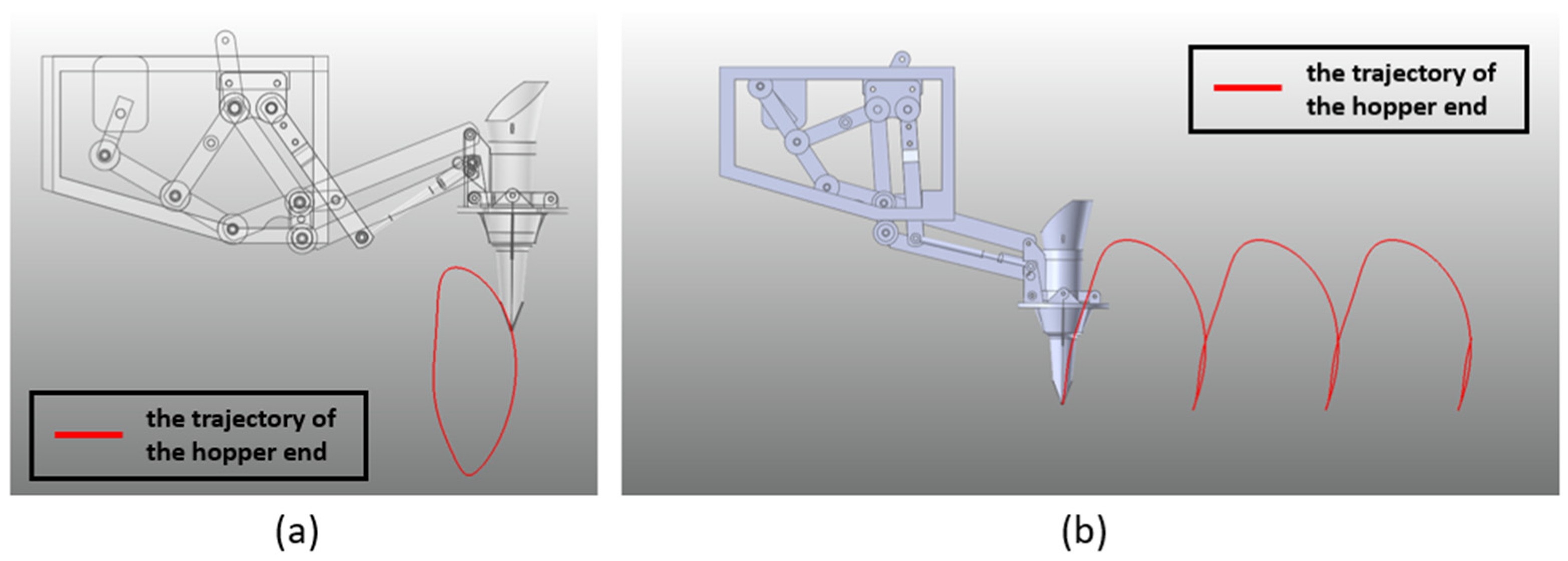
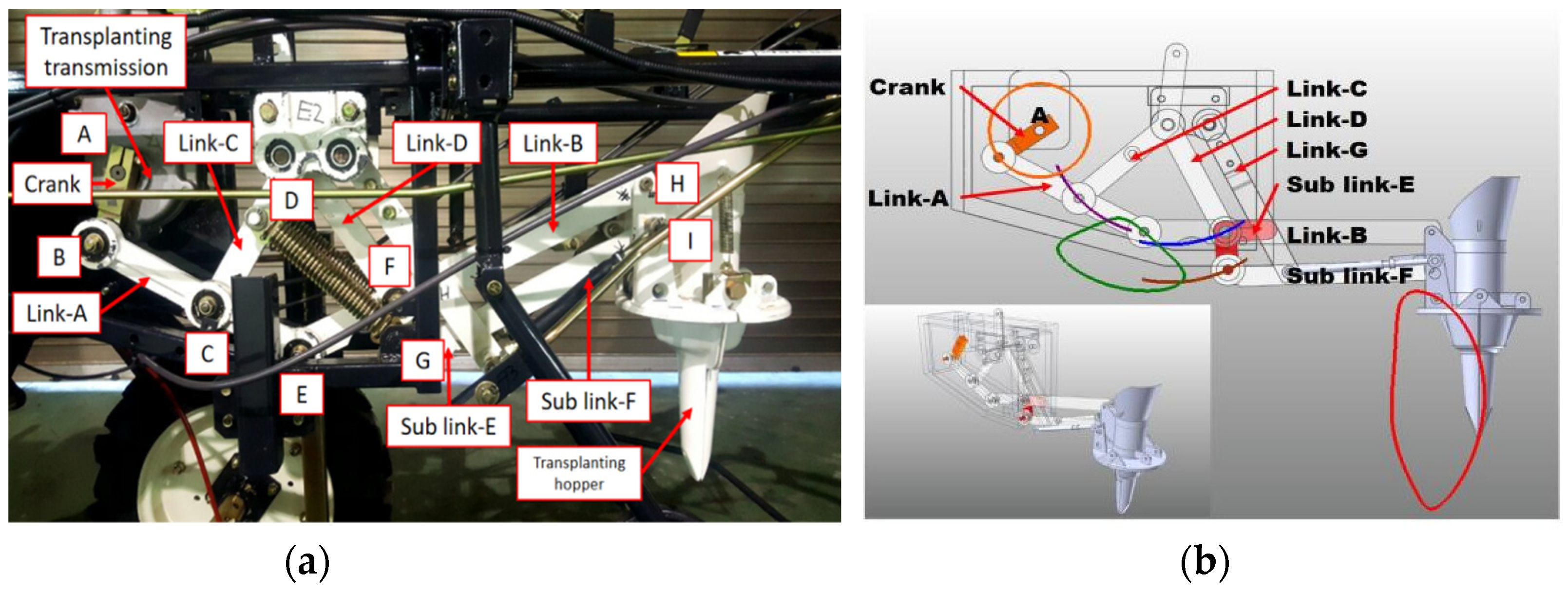

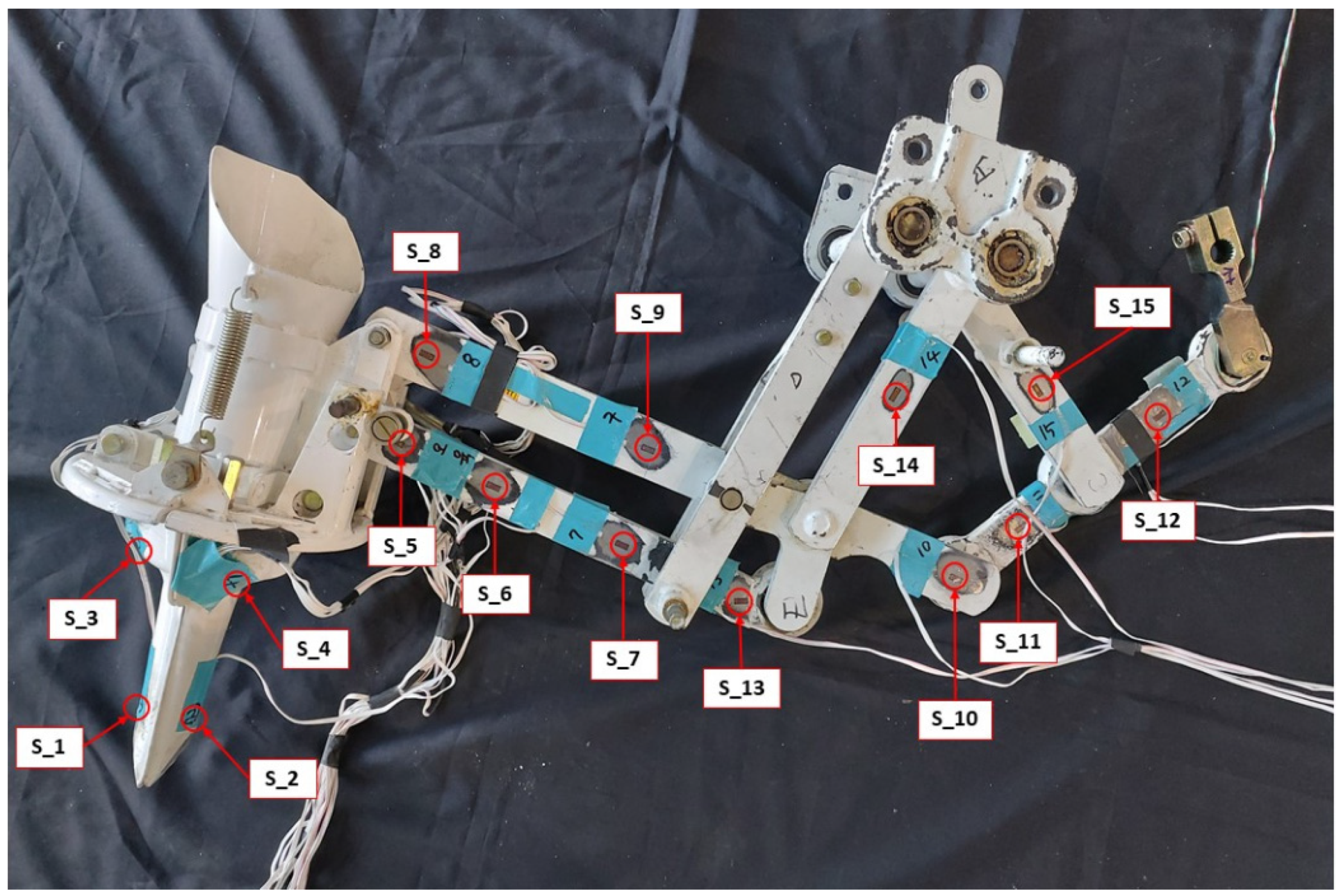
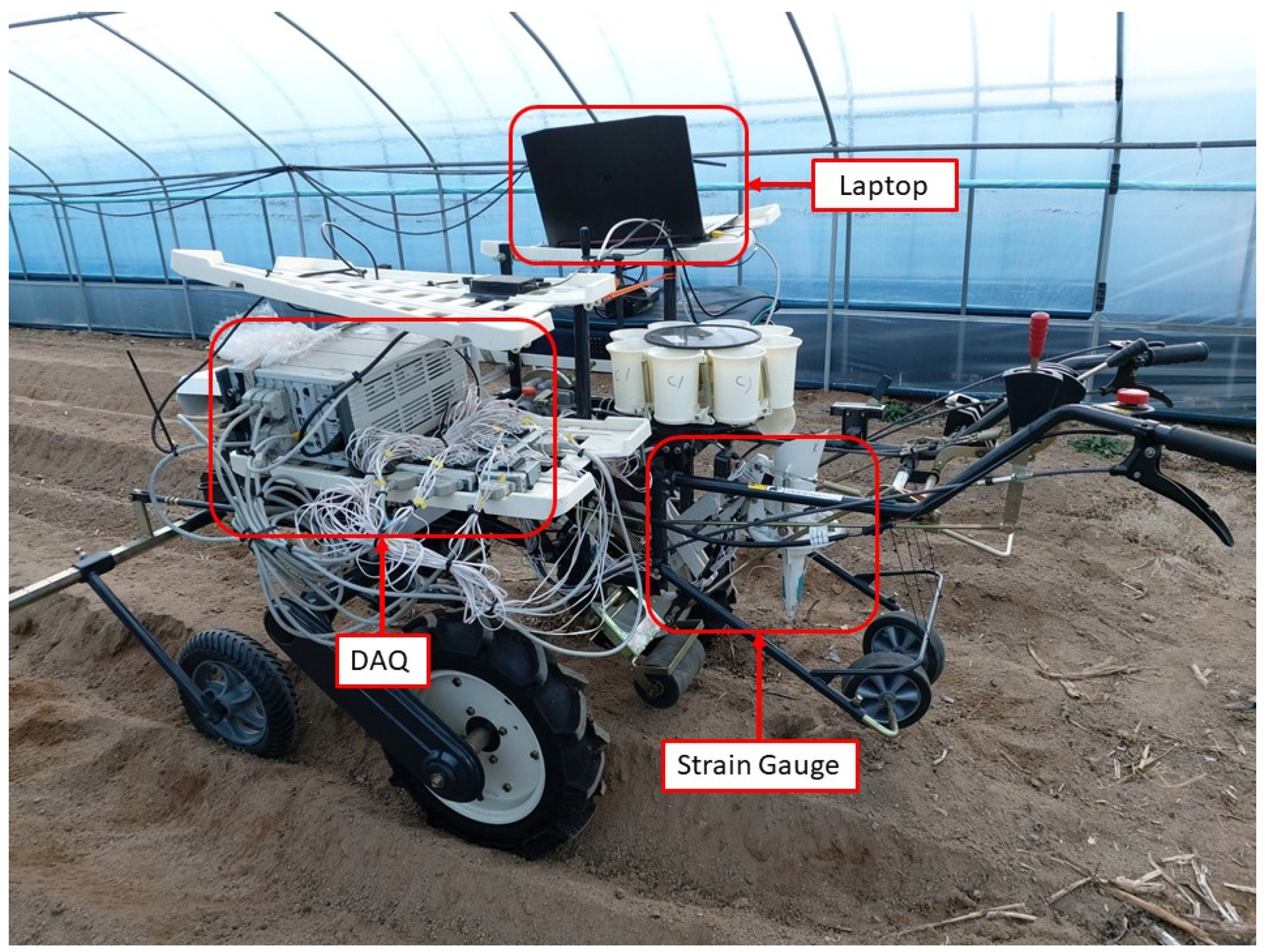
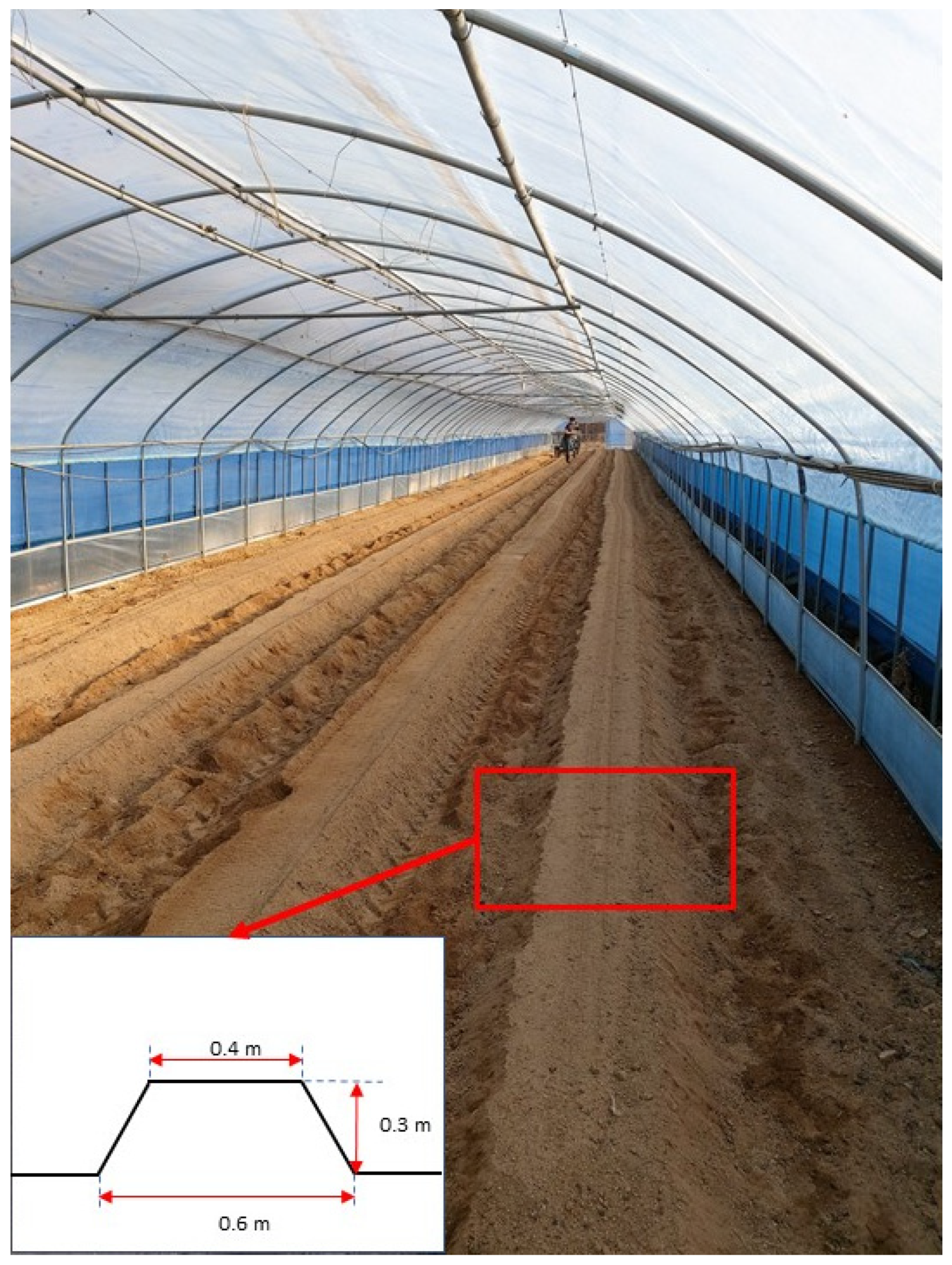
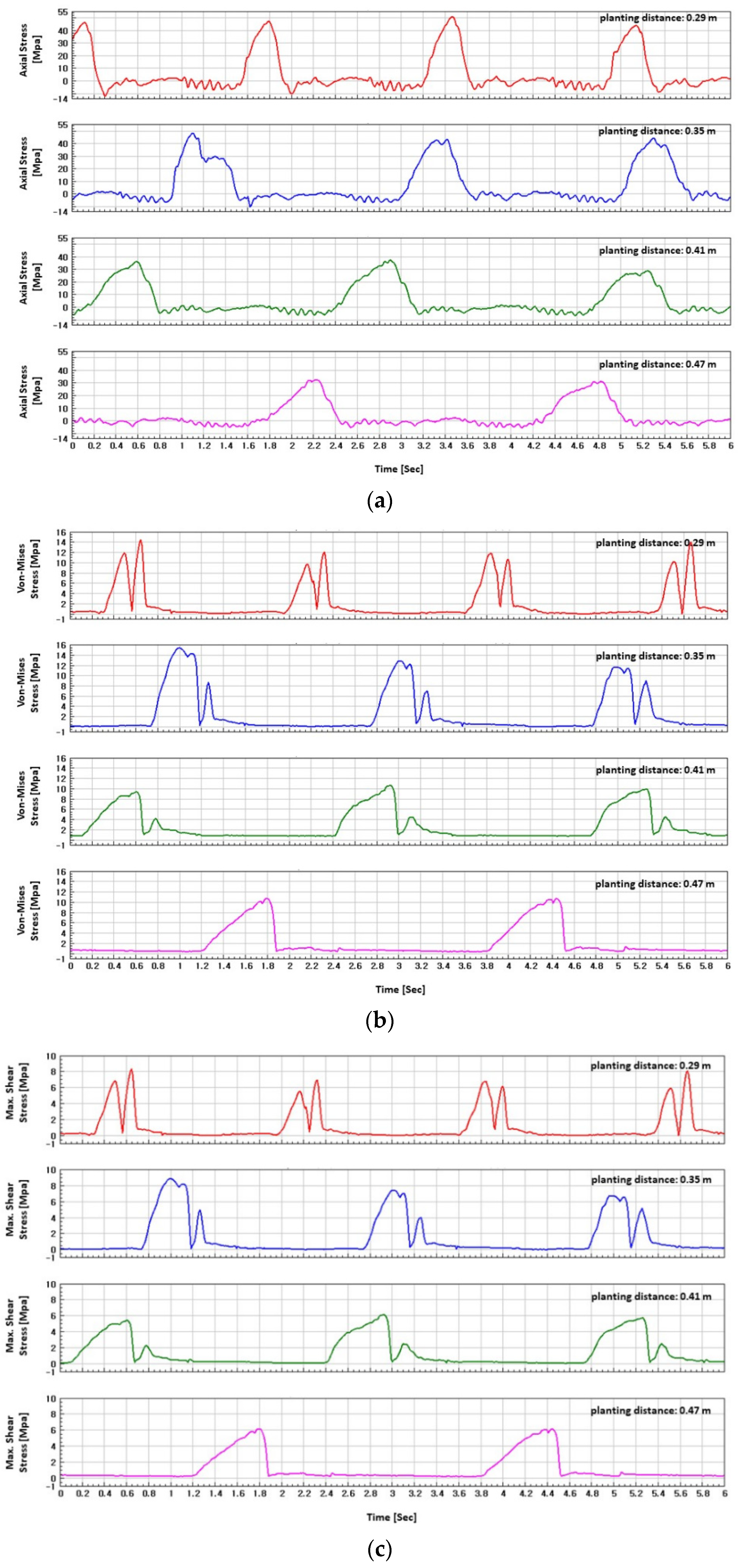
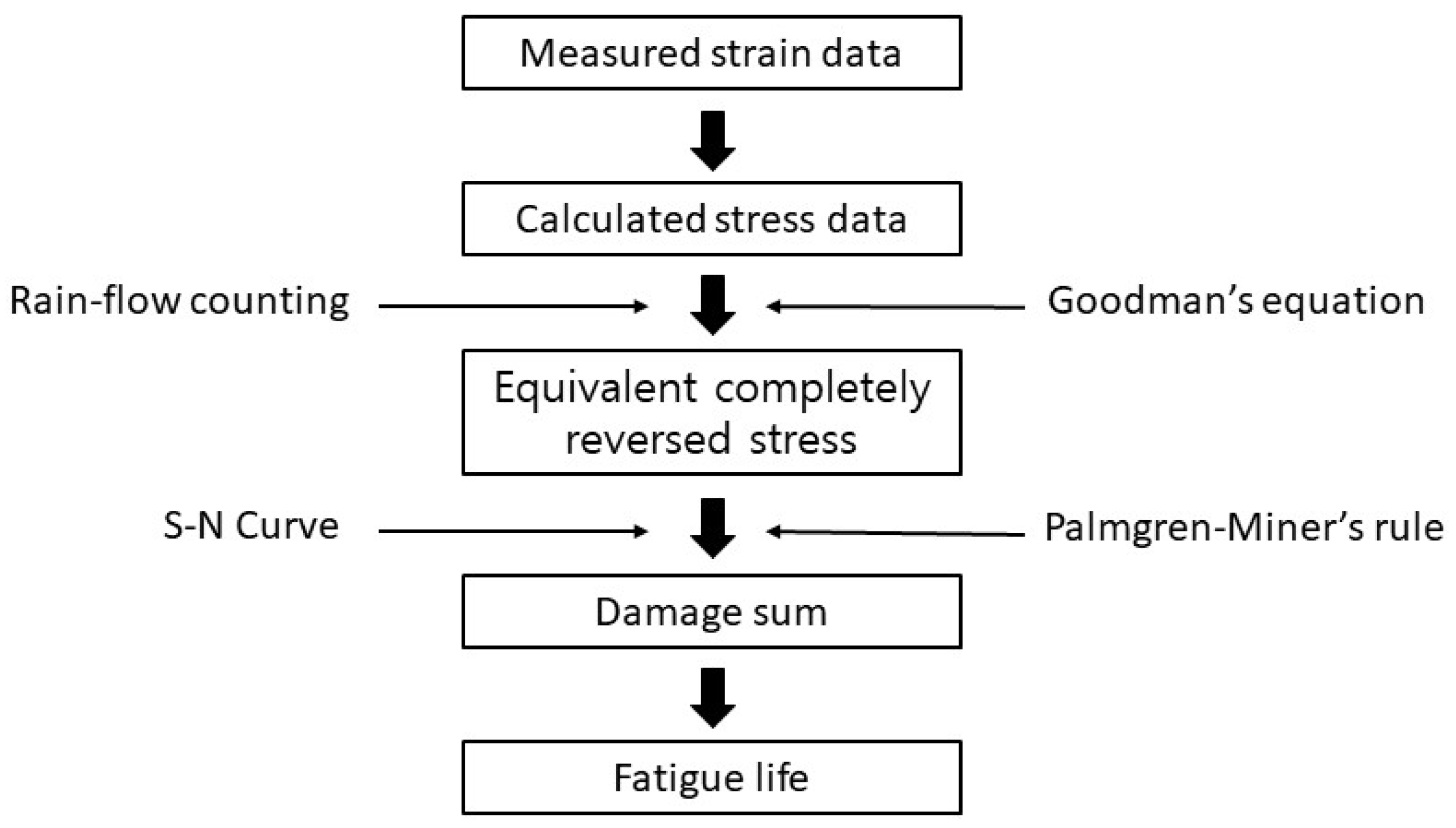
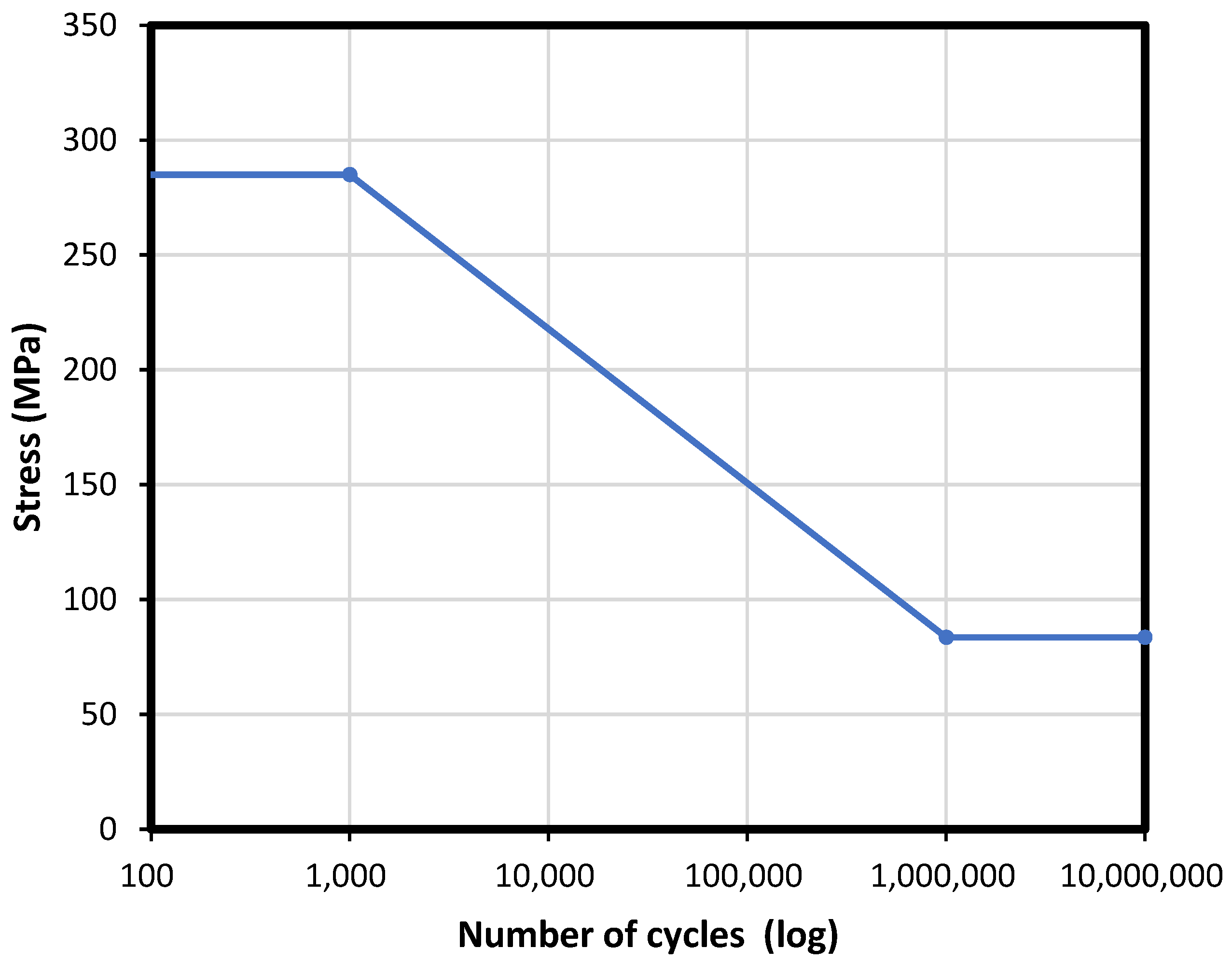

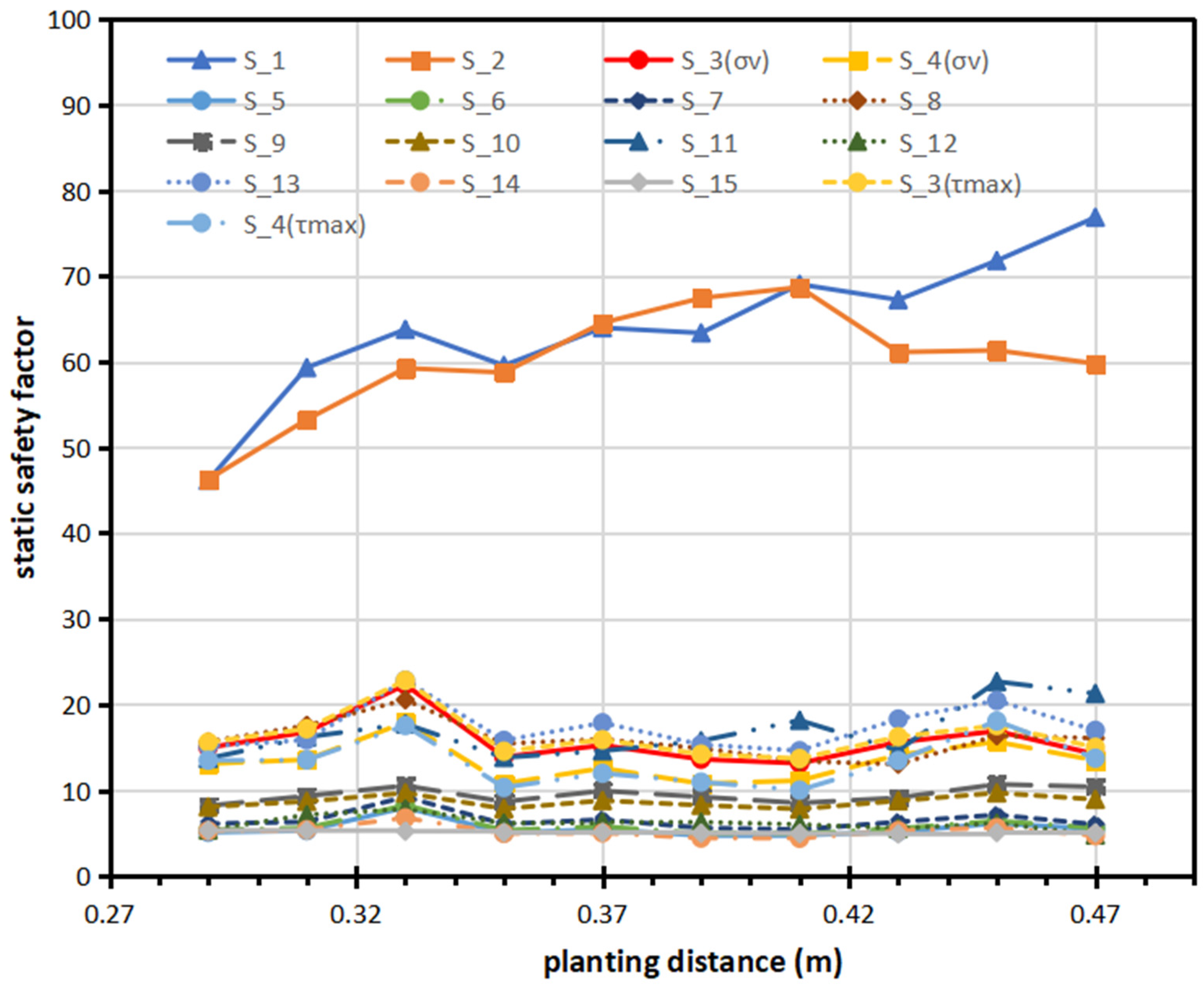
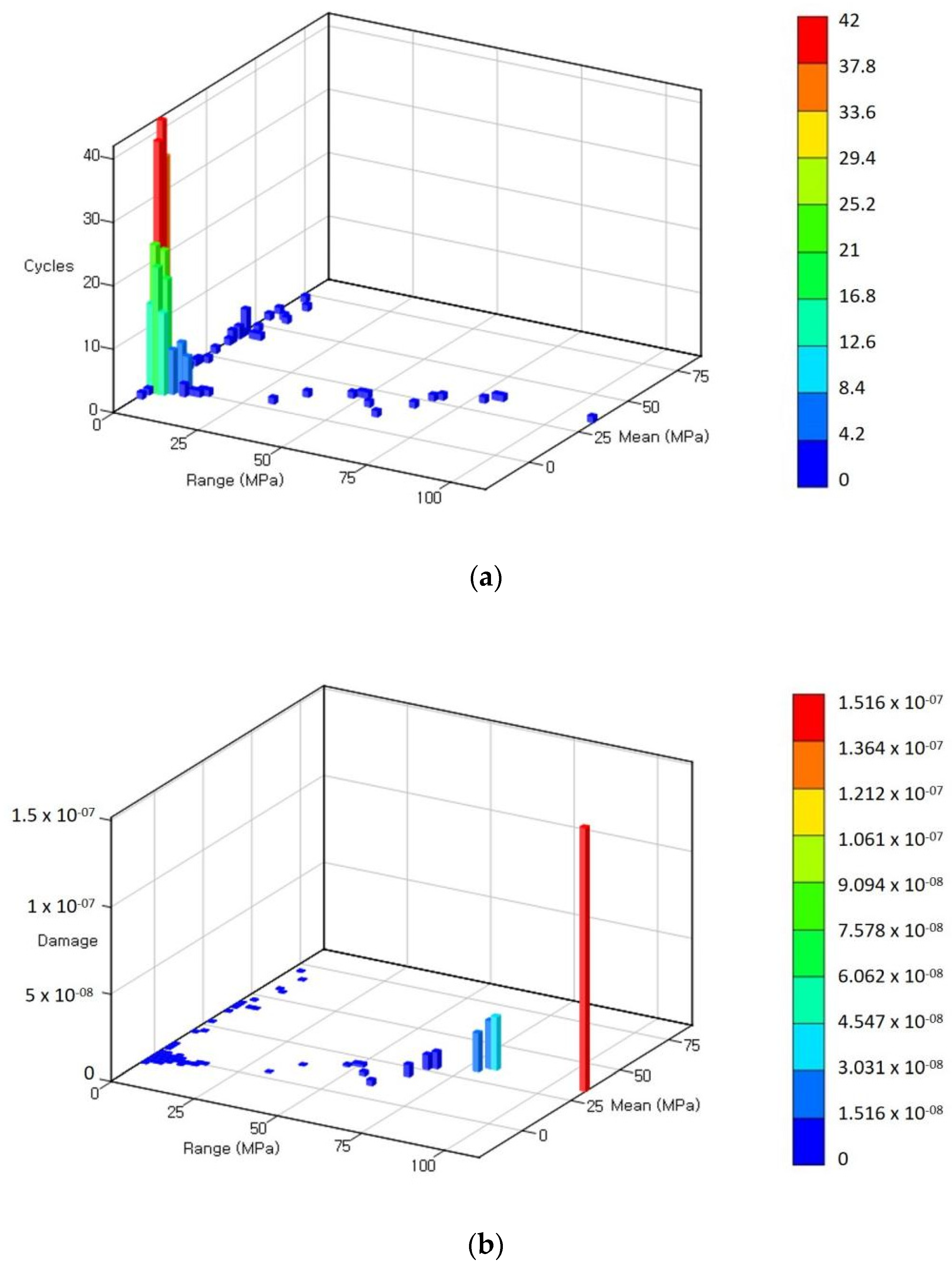
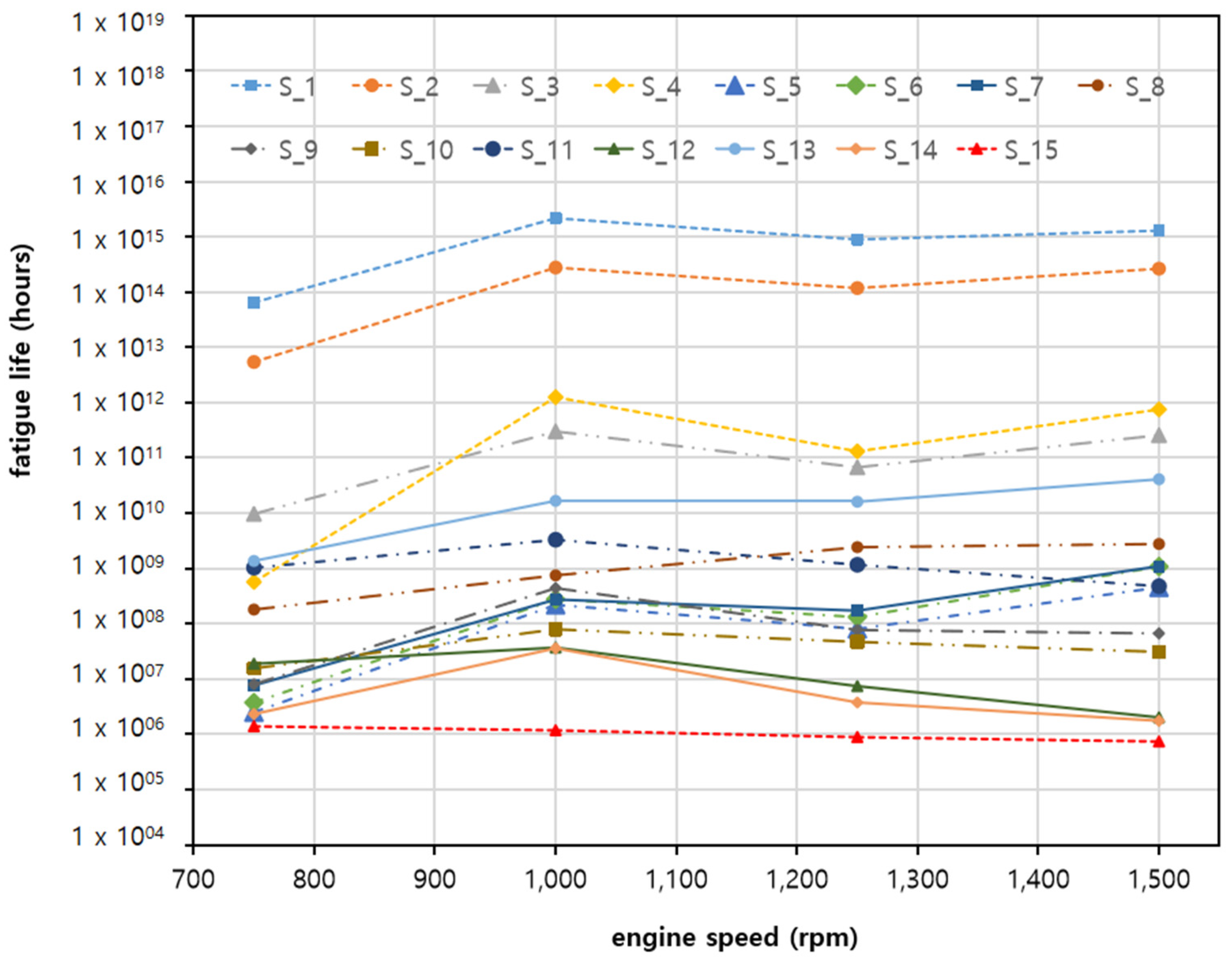
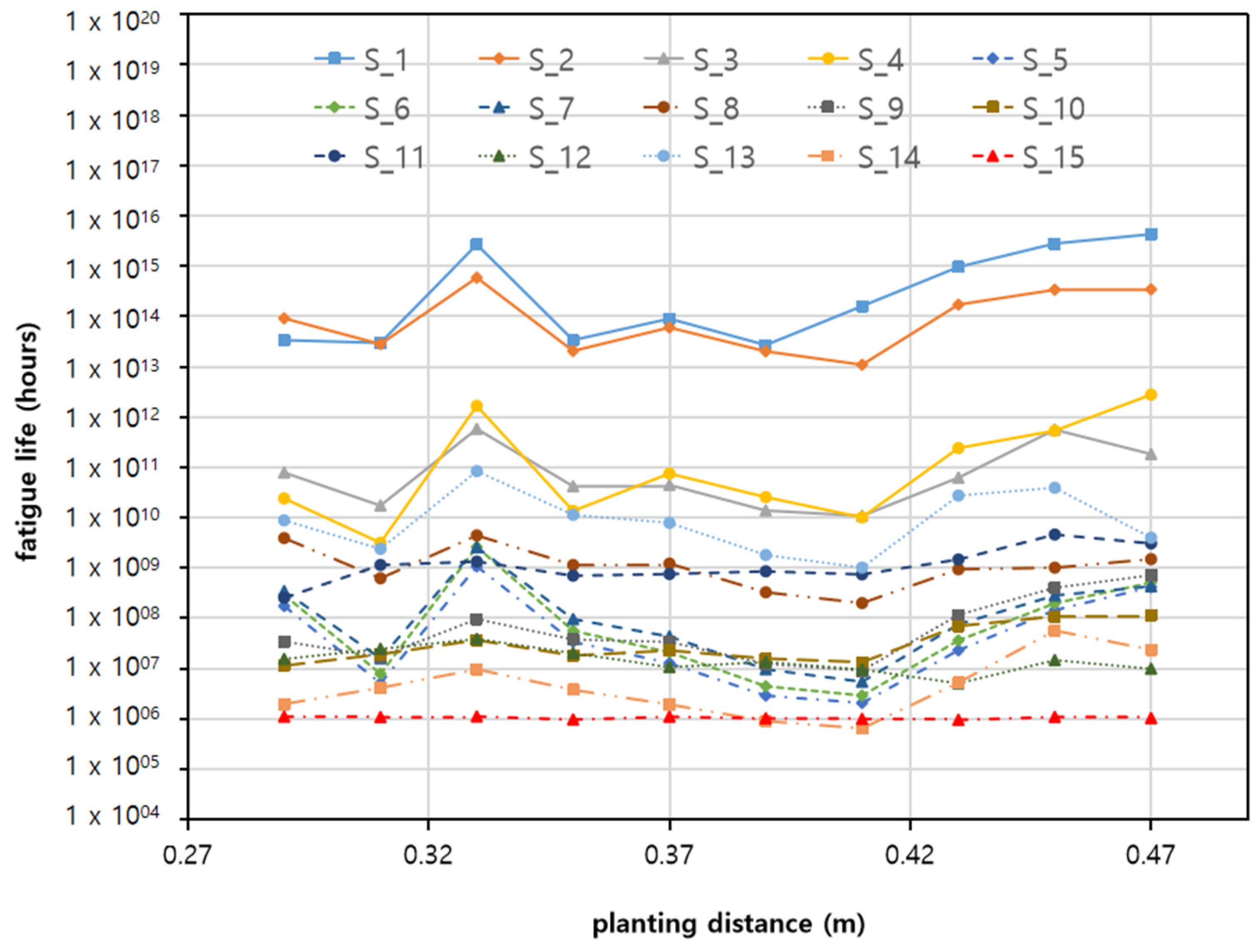
| Items | Specifications | |
|---|---|---|
| Model | KTP-30 | |
| Length/Width/Height | mm | 2125/1180/1510 |
| Weight | kg | 199 |
| Engine | Rated power (kW) | 3.4 |
| Rated speed (rpm) | 1800 | |
| Wheel adjustment(Inner/Outer) | mm | 360~750/1170~1550 |
| Plant spacing | mm | 300–500 |
| Rated working speed | m/s | 0.2–0.4 |
| Working efficiency | h/m2 | 0.08 |
| Item | Steel Alloy 1020 |
|---|---|
| Density, ρ (kg/m3) | 7.85 × 103 |
| Modulus of elasticity, E (GPa) | 207 |
| Poisson’s Ratio, ν | 0.3 |
| Yield strength, Sy (MPa) | 210 |
| Yield strength in shear, Ssy (MPa) | 105 |
| Ultimate strength, Sut (MPa) | 380 |
| Fatigue strength of 106 cycles, Sn (MPa) | 190 |
| Load factor (CL) | 1.0 |
| Gradient factor (CG) | 0.7 |
| Surface factor (CS) | 0.7 |
| Temperature factor (CT) | 1.0 |
| Reliability factor (CR) | 0.897 |
| Source of Variation | SS | df | MS | F | F Crit | p-Value |
|---|---|---|---|---|---|---|
| Sample (engine speed) | 2.49 × 1016 | 3 | 8.31 × 1015 | 3.17 | 2.72 | 0.03 |
| Columns (planting distance) | 3.35 × 1016 | 9 | 3.72 × 1015 | 1.42 | 1.99 | 0.19 |
| Interaction | 1.01 × 1017 | 27 | 3.75 × 1015 | 1.43 | 1.63 | 0.11 |
| Within | 2.1 × 1017 | 80 | 2.63 × 1015 | |||
| Total | 3.7 × 1017 | 119 |
Publisher’s Note: MDPI stays neutral with regard to jurisdictional claims in published maps and institutional affiliations. |
© 2022 by the authors. Licensee MDPI, Basel, Switzerland. This article is an open access article distributed under the terms and conditions of the Creative Commons Attribution (CC BY) license (https://creativecommons.org/licenses/by/4.0/).
Share and Cite
Sri, M.; Hwang, S.-J.; Nam, J.-S. Experimental Safety Analysis for Transplanting Device of the 4-Bar Link Type Semi-Automatic Vegetable Transplanter. Agronomy 2022, 12, 1890. https://doi.org/10.3390/agronomy12081890
Sri M, Hwang S-J, Nam J-S. Experimental Safety Analysis for Transplanting Device of the 4-Bar Link Type Semi-Automatic Vegetable Transplanter. Agronomy. 2022; 12(8):1890. https://doi.org/10.3390/agronomy12081890
Chicago/Turabian StyleSri, Markumningsih, Seok-Joon Hwang, and Ju-Seok Nam. 2022. "Experimental Safety Analysis for Transplanting Device of the 4-Bar Link Type Semi-Automatic Vegetable Transplanter" Agronomy 12, no. 8: 1890. https://doi.org/10.3390/agronomy12081890
APA StyleSri, M., Hwang, S.-J., & Nam, J.-S. (2022). Experimental Safety Analysis for Transplanting Device of the 4-Bar Link Type Semi-Automatic Vegetable Transplanter. Agronomy, 12(8), 1890. https://doi.org/10.3390/agronomy12081890








